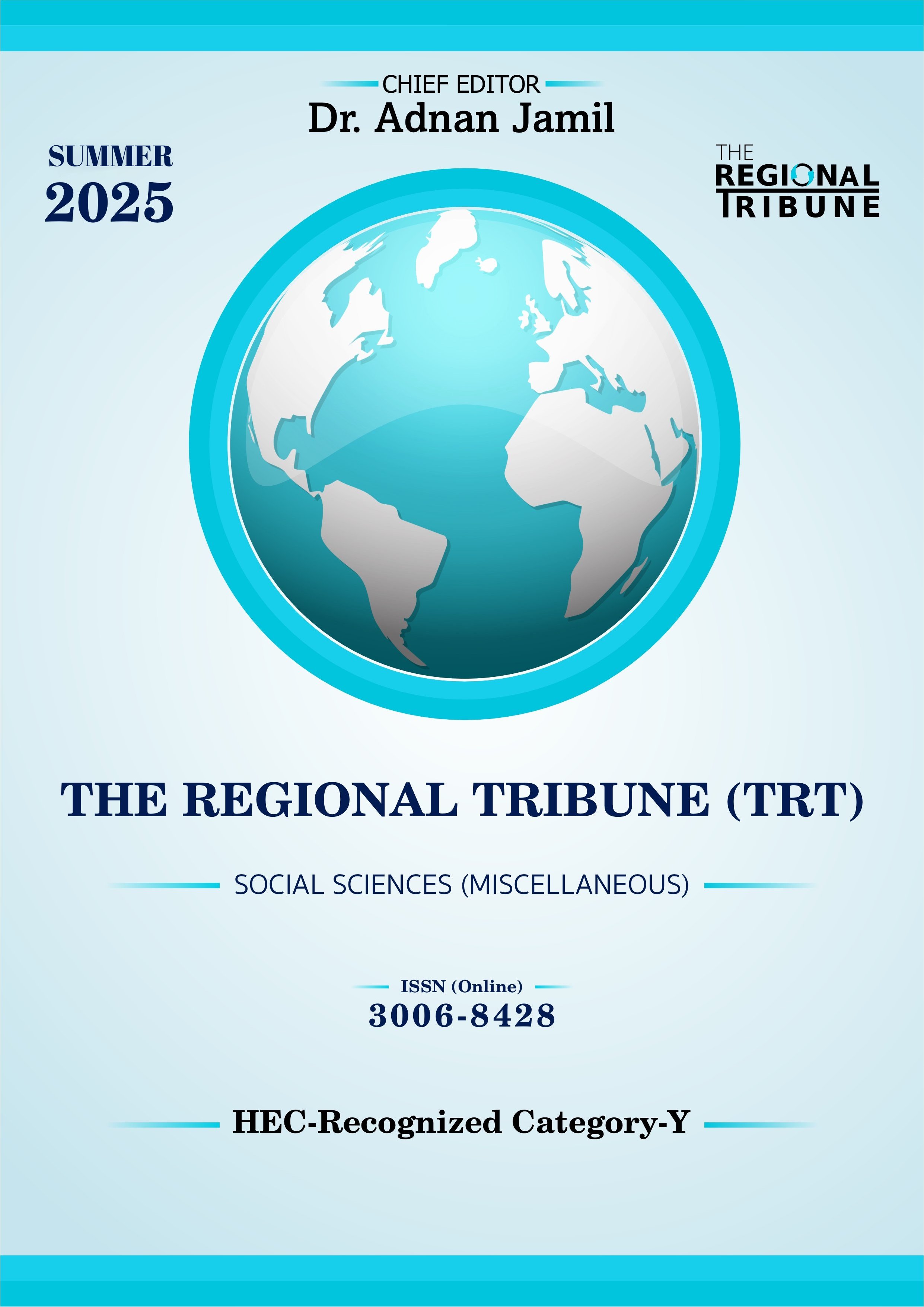Metaverse as a New Medium: Contemporary Research Trends in Media & Communication Discipline
DOI:
https://doi.org/10.55737/trt/SR25.133Keywords:
Metaverse, Media & Communication, New Medium, Systematic Review, Sociotechnical ImaginariesAbstract
With the invention of every new medium, either newspaper, radio, film, television, internet, and digital communication technologies, the media & and communication as a discipline evolved in terms of new theoretical approaches, methodologies, practices, and especially the effects of the medium on every aspect of human lives. The recent trends of research in this discipline have shown how the specific medium will be important for society in connection with its effects and future implications. The creation and upgradation of new theories and methodologies also depend on research trends. Metaverse, as a virtual and immersive communication tool, is emerging in every aspect of human life, and scholars are predicting that in the future, Metaverse will lead communication technologies. This research aims to explore the Metaverse as a new medium and its implications in the media & and communication discipline field. Through the systematic review of the 50 most relevant articles, this research explored the contemporary research trends in the Media and communication discipline related to the Metaverse. The Metaverse as a new medium has been investigated dominantly as a source of audience virtual and immersive social interaction, immersive entertainment, and an effective gaming medium. The evolution of the medium is the message, impactful on users' experience, evolution in the advertisement & marketing, privacy & ethical concerns, as a tool of education, and the new global village. With the help of the sociotechnical imaginaries theory, this research highlights the futuristic importance of the Metaverse in this discipline.
References
Arsenault, A. M. (2022). Understanding media richness and social presence: understanding media richness and social presence: exploring the impacts of media channels on exploring the impacts of media channels on individuals’ levels of loneliness, well-being, and individuals’ levels of loneliness, well-being, and belonging belonging. Https://scholarworks.umt.edu/etd
Balaji, M. S., & Chakrabarti, D. (2010). Student Interactions in Online Discussion Forum: Empirical Research from “Media Richness Theory” Perspective. Journal of Interactive Online Learning Www.Ncolr.Org/Jiol, 9(1).
Barta, S., Gurrea, R., & Flavián, C. (2023). Telepresence in live-stream shopping: An experimental study comparing Instagram and the metaverse. Electronic Markets, 33(1). https://doi.org/10.1007/s12525-023-00643-6
Bhattacharya, P., Saraswat, D., Savaliya, D., Sanghavi, S., Verma, A., Sakariya, V., Tanwar, S., Sharma, R., Raboaca, M. S., & Manea, D. L. (2023). Towards Future Internet: The Metaverse Perspective for Diverse Industrial Applications. Mathematics, 11(4). 941, https://doi.org/10.3390/math11040941
Chen, X., Zou, D., Xie, H., & Wang, F. L. (2023). Metaverse in Education: Contributors, Cooperations, and Research Themes. IEEE Transactions on Learning Technologies, 16(6).
Crespo-Pereira, V., Sánchez-Amboage, E., & Membiela-Pollán, M. (2023). Facing the challenges of the metaverse: a systematic literature review from Social Sciences, Marketing and Communication. Profesional de La Informacion, 32(1). https://doi.org/10.3145/epi.2023.ene.02
Gao, W., Li, L., Xue, Y., Li, Y., & Zhang, J. (2023). Design of security management model for communication networks in digital cultural consumption under Metaverse – The case of mobile game. Egyptian Informatics Journal, 24(2). https://doi.org/10.1016/j.eij.2023.05.004
Guegan, J., Nelson, J., Lamy, L., & Buisine, S. (2020). Actions speak louder than looks: The effects of avatar appearance and in-game actions on subsequent prosocial behavior. Cyberpsychology, 14(4), 1–16. https://doi.org/10.5817/CP2020-4-1
Han, E., Miller, M. R., DeVeaux, C., Jun, H., Nowak, K. L., Hancock, J. T., Ram, N., & Bailenson, J. N. (2023). People, places, and time: a large-scale, longitudinal study of transformed avatars and environmental context in group interaction in the metaverse. Journal of Computer-Mediated Communication, 28(2). https://doi.org/10.1093/jcmc/zmac031
Han, J., Heo, J., & You, E. (2021, October). Analysis of metaverse platform as a new play culture: Focusing on roblox and zepeto. In International conference on human-centered artificial intelligence (pp. 1-10). http://star.informatik.rwth-aachen.de/Publications/CEUR-WS/Vol-3026/paper3.pdf
Han, X., & Yeoun, M. (2023). Exploring the Uncertainty Perceived According to the Purpose of Communication Among Social Interactions in the Metaverse. Archives of Design Research, 36(2). https://doi.org/10.15187/adr.2023.05.36.2.195
Hatmanto, E. D., Pratolo, B. W., & Sari, M. I. (2023). Metaverse magic: Unveiling the pedagogical potential and transformative effects on intercultural communication in English language teaching. English Language Teaching Educational Journal, 6(1). https://doi.org/10.12928/eltej.v6i1.8627
He, L., Liu, K., He, Z., & Cao, L. (2023). Three-dimensional holographic communication system for the metaverse. Optics Communications, 526. https://doi.org/10.1016/j.optcom.2022.128894
Hooi, R., & Cho, H. (2013). Deception in avatar-mediated virtual environment. Computers in Human Behavior, 29(1), 276–284. https://doi.org/10.1016/j.chb.2012.09.004
Kalyvaki, M., McIntosh, H., & Nash, K. (2023). Virtual selfhood and consumer behavior: Exploring avatar attachment and consumption patterns in Second Life’s metaverse. Computers in Human Behavior: Artificial Humans, 1(2), 100016. https://doi.org/10.1016/j.chbah.2023.100016
Ki, C.-W. C., Youn, S.-Y., & Ha, S. (2023). METAVERSE AND FASHION CONSUMERS: EXPLORING THE MEANINGS CONSUMERS ATTACH TO THE METAVERSE, AVATARS, AND DIGITAL FASHION. Global Fashion Management Conference, 209–213. https://doi.org/10.15444/gmc2023.03.03.04
Lam, K. Y., Yang, L., Alhilal, A., Lee, L. H., Tyson, G., & Hui, P. (2022, December). Human-avatar interaction in metaverse: Framework for full-body interaction. In Proceedings of the 4th ACM International Conference on Multimedia in Asia (pp. 1-7).
Larey, A., Asraf, O., Kelder, A., Wilf, I., Kruzel, O., & Daniel, N. (2023). Facial Expression Re-targeting from a Single Character. ArXiv.org. http://arxiv.org/abs/2306.12188
Lee & Kims. (2023). unified theory-of-acceptance-and-use-of-technology. Papagiannidis (Ed).
Lee, C. T., Ho, T. Y., & Xie, H. H. (2023). Building brand engagement in metaverse commerce: The role of branded non-fungible toekns (BNFTs). Electronic Commerce Research and Applications, 58. https://doi.org/10.1016/j.elerap.2023.101248
Lee, H. W., Chang, K., Uhm, J. P., & Owiro, E. (2023). How Avatar Identification Affects Enjoyment in the Metaverse: The Roles of Avatar Customization and Social Engagement. Cyberpsychology, Behavior, and Social Networking, 26(4), 255–262. https://doi.org/10.1089/cyber.2022.0257
Lim, W. Y. B., Xiong, Z., Niyato, D., Cao, X., Miao, C., Sun, S., & Yang, Q. (2023). Realizing the Metaverse with Edge Intelligence: A Match Made in Heaven. IEEE Wireless Communications, 30(4). https://doi.org/10.1109/MWC.018.2100716
Lin, Y., Du, H., Niyato, D., Nie, J., Zhang, J., Cheng, Y., & Yang, Z. (2023). Blockchain-Aided Secure Semantic Communication for AI-Generated Content in Metaverse. IEEE Open Journal of the Computer Society, 1–12. https://doi.org/10.1109/ojcs.2023.3260732
Lin, Y., Gao, Z., Du, H., Niyato, D., Kang, J., Jamalipour, A., & Shen, X. S. (2024). A Unified Framework for Integrating Semantic Communication and AI-Generated Content in Metaverse. IEEE Network, 38(4), 174–181. https://doi.org/10.1109/mnet.2023.3321539
Lyu, Z. (2023a). State-of-the-Art Human-Computer-Interaction in Metaverse. International Journal of Human-Computer Interaction. 40(21), 6690-6708. https://doi.org/10.1080/10447318.2023.2248833
Mammadov, R. (2022). Media Choice in Times of Uncertainty <br/>—Media Richness Theory in Context of Media Choice in Times of Political and Economic Crisis. Advances in Journalism and Communication, 10(02), 53–69. https://doi.org/10.4236/ajc.2022.102005
Melin, R. (2021a). Pushing buttons: an ethnographic interview study on toxicity in online gaming cultures.
Meng, Z., She, C., Zhao, G., & De Martini, D. (2023). Sampling, Communication, and Prediction Co-Design for Synchronizing the Real-World Device and Digital Model in Metaverse. IEEE Journal on Selected Areas in Communications, 41(1). https://doi.org/10.1109/JSAC.2022.3221993
Mennecke, B. E., Triplett, J. L., Hassall, L. M., Conde, Z. J., & Heer, R. (2011). An Examination of a Theory of Embodied Social Presence in Virtual Worlds*. Decision Sciences, 42(2), 413–450. https://doi.org/10.1111/j.1540-5915.2011.00317.x
Morgan, R. (2018). Virtual reality: an ethnographic study of sociality, being, and money in a multi-player online game-world. http://researchonline.jcu.edu.au/41004/
Murphy, K. M., Cook, A. L., & Fallon, L. M. (2021). Mixed reality simulations for social-emotional learning. Phi Delta Kappan, 102(6), 30–37. https://doi.org/10.1177/0031721721998152
Nagendran, A., Compton, S., Follette, W. C., Golenchenko, A., Compton, A., & Grizou, J. (2022). Avatar led interventions in the Metaverse reveal that interpersonal effectiveness can be measured, predicted, and improved. Scientific Reports, 12(1). 21892. https://doi.org/10.1038/s41598-022-26326-4
Nan, D., Sun, S., Jansen, B. J., & Kim, J. H. (2023). Beyond Avatar Coolness: Exploring the Effects of Avatar Attributes on Continuance Intention to Play Massively Multiplayer Online Role-Playing Games. International Journal of Human-Computer Interaction. https://doi.org/10.1080/10447318.2023.2278941
Park, J., & Kim, N. (2023). Examining self-congruence between user and avatar in purchasing behavior from the metaverse to the real world. Journal of Global Fashion Marketing. https://doi.org/10.1080/20932685.2023.2180768
Rahman, M. H., Sejan, M. A. S., Aziz, M. A., Kim, D. S., You, Y. H., & Song, H. K. (2023). Spectral Efficiency Analysis for IRS-Assisted MISO Wireless Communication: A Metaverse Scenario Proposal. Mathematics, 11(14). https://doi.org/10.3390/math11143181
Rapuano, M., Ferrara, A., Sbordone, F. L., & Ruotolo, F. (2020). The Appearance of the Avatar Can Enhance the Sense of Co-Presence During Virtual Interactions with Users. https://www.researchgate.net/publication/345767163
Roy, R., Babakerkhell, M. D., Mukherjee, S., Pal, D., & Funilkul, S. (2023). Development of a Framework for Metaverse in Education: A Systematic Literature Review Approach. IEEE Access, 11. https://doi.org/10.1109/ACCESS.2023.3283273
Scheiding, R. (2023). Designing the Future? The Metaverse, NFTs, & the Future as Defined by Unity Users. Games and Culture, 18(6). https://doi.org/10.1177/15554120221139218
Simon, S. J., & Peppas, S. C. (2004). An examination of media richness theory in product Web site design: An empirical study. Info, 6(4), 270–281. https://doi.org/10.1108/14636690410555672
Siuda, D. (2021a). Typology of virtual brand communities’ members. Procedia Computer Science, 192, 2190–2198. https://doi.org/10.1016/J.PROCS.2021.08.232
Sterna, R., & Zibrek, K. (2021). Psychology in Virtual Reality: Toward a Validated Measure of Social Presence. Frontiers in Psychology, 12. https://doi.org/10.3389/fpsyg.2021.705448
Szolin, K., Kuss, D. J., Nuyens, F. M., & Griffiths, M. D. (2023). Exploring the user-avatar relationship in videogames: A systematic review of the Proteus effect. Human-Computer Interaction, 38(5–6), 374–399. https://doi.org/10.1080/07370024.2022.2103419
Tang, F., Chen, X., Zhao, M., & Kato, N. (2023). The Roadmap of Communication and Networking in 6G for the Metaverse. IEEE Wireless Communications, 30(4). https://doi.org/10.1109/MWC.019.2100721
Voinea, G. D., Gîrbacia, F., Postelnicu, C. C., Duguleana, M., Antonya, C., Soica, A., & Stănescu, R. C. (2022a). Study of Social Presence While Interacting in Metaverse with an Augmented Avatar during Autonomous Driving. Applied Sciences (Switzerland), 12(22). https://doi.org/10.3390/app122211804
Wang, Z. (2022). Media Richness and Continuance Intention to Online Learning Platforms: The Mediating Role of Social Presence and the Moderating Role of Need for Cognition. Frontiers in Psychology, 13. https://doi.org/10.3389/fpsyg.2022.950501
Weidlich, J., & Bastiaens, T. J. (2017). Explaining social presence and the quality of online learning with the SIPS model. Computers in Human Behavior, 72, 479-487.
Xu, M., Ng, W. C., Lim, W. Y. B., Kang, J., Xiong, Z., Niyato, D., Yang, Q., Shen, X., & Miao, C. (2023). A Full Dive Into Realizing the Edge-Enabled Metaverse: Visions, Enabling Technologies, and Challenges. IEEE Communications Surveys and Tutorials, 25(1). https://doi.org/10.1109/COMST.2022.3221119
Xu, W. (2023). Research on the International Communication under Metaverse. Lecture Notes in Education Psychology and Public Media, 4(1). https://doi.org/10.54254/2753-7048/4/2022146
Yim, Y. S., & Chang, W. (2023). SAD AVATARS AS BETTER SALES REPRESENTATIVES IN THE METAVERSE? THE ROLE OF SUBCULTURAL APPEAL. Global Fashion Management Conference, 113–113. https://doi.org/10.15444/GMC2023.02.03.06
Yu, W., Chua, T. J., & Zhao, J. (2023). Asynchronous Hybrid Reinforcement Learning for Latency and Reliability Optimization in the Metaverse Over Wireless Communications. IEEE Journal on Selected Areas in Communications, 41(7). https://doi.org/10.1109/JSAC.2023.3280988
Zhang, G., Cao, J., Liu, D., & Qi, J. (2022a). Popularity of the metaverse: Embodied social presence theory perspective. Frontiers in Psychology, 13. https://doi.org/10.3389/fpsyg.2022.997751
Zhang, L., Du, Q., Lu, L., & Zhang, S. (2023). Overview of the Integration of Communications, Sensing, Computing, and Storage as Enabling Technologies for the Metaverse over 6G Networks. Electronics (Switzerland), 12(17). https://doi.org/10.3390/electronics12173651
Downloads
Published
Issue
Section
License
Copyright (c) 2025 Erum Waheed, Muhammad Rashid, Khurram Saleem

This work is licensed under a Creative Commons Attribution-NonCommercial 4.0 International License.



